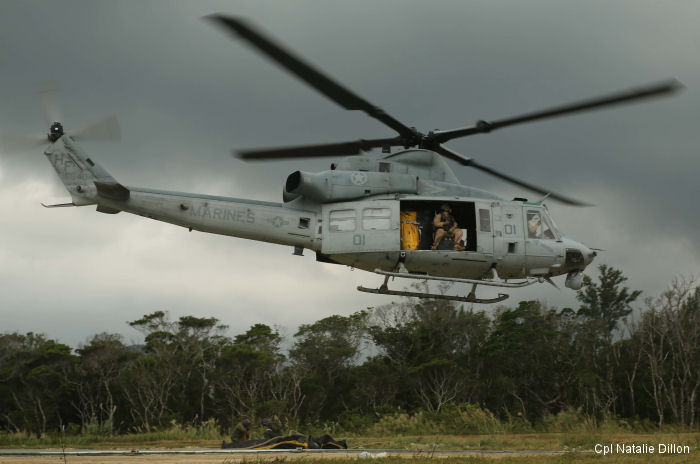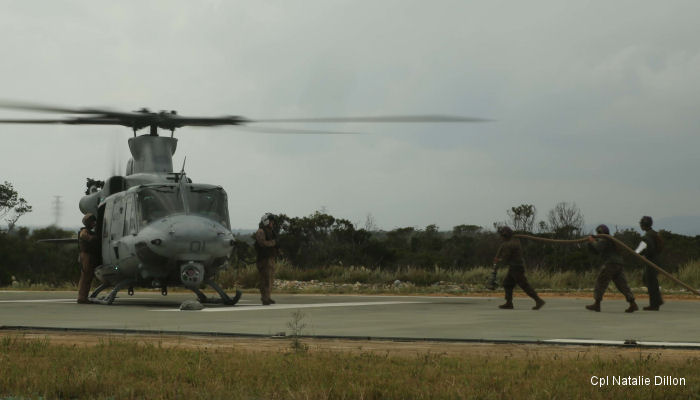
US Marine Corps, October 31, 2015 - CAMP HANSEN, Okinawa, Japan by Cpl Natalie Dillon - The staccato thump of Cobra, Huey, and Super Stallion rotors turns to a roar of white noise as the birds slowly descend. Below, Marines and Sailors in crusted clay covered utility uniforms stand ready, hands welded to the pistol grips of their rifles in anticipation of boarding the aircraft for the impending air assault.
The Marine and Sailor team of III Marine Expeditionary Force rely on forward armament and refueling points, called FARPs, to project combat power and seize the initiative from the enemy. FARPs, which provide fuel, ammunition and ordinance, powered a massive regimental air assault today. The Marines operating the FARP sites are an integral part of Blue Chromite, allowing all elements of the Marine Air Ground Task Force to push farther, longer.
Because a FARP doesn’t represent the climax of combat, it isn’t the first image of warfare for the average person. During Blue Chromite, multiple FARPs were used to open up the combat arena for ground troops and aircraft.
Medium Marine Tiltrotor Squadron 262 operated a FARP on Ie Shima during Blue Chromite to support a simulated tactical recovery of a downed aircraft. It enabled a UH-1Y Huey to escort a recovery crew traveling on a CH-53 Super Stallion. During the mission, an Osprey transported fuel and ordnance to establish the FARP at a forward location, deep within the kinetic environment. When a FARP is moved to a forward location this way, the aviation community calls it a Spider FARP.
Capt. Jens Gilbertson, a Huey pilot with Marine Light Attack Helicopter Squadron 269, Marine Air Group 36, 1st Marine Aircraft Wing, III MEF, said Spider FARPs are rare, as this is the first Spider FARP MAG 36 has conducted on Okinawa, he said.
In addition to the aircraft recovery mission, FARPs played a role in the following training events in Blue Chromite: two amphibious assaults, a mass casualty drill and today’s regimental air assault.
Sgt. Misty L. Crowsey, a bulk fuel specialist with Marine Wing Support Squadron 172, MAG 36, was one of the Marines involved in refueling aircraft during the FARP today at landing zone Phoenix. She said the experience will prepare her Marines to execute FARPs when the mission depends on them in any future operations.
“We try to stress to the Marines that they need to practice how they would fight,” said Crowsey.
Pfc. Ethan P. Bryant, a bulk fuel specialist with MWSS-172, also touched on the connection between training and operations.
“Blue Chromite captures a combat scenario because we learn how to be better and faster at giving the birds what they need to get back out and fight,” said Bryant. “I also get a chance to pass on my knowledge to new (Marines), and that helps me get better too.”
The Marine and Sailor team of III Marine Expeditionary Force rely on forward armament and refueling points, called FARPs, to project combat power and seize the initiative from the enemy. FARPs, which provide fuel, ammunition and ordinance, powered a massive regimental air assault today. The Marines operating the FARP sites are an integral part of Blue Chromite, allowing all elements of the Marine Air Ground Task Force to push farther, longer.
Because a FARP doesn’t represent the climax of combat, it isn’t the first image of warfare for the average person. During Blue Chromite, multiple FARPs were used to open up the combat arena for ground troops and aircraft.
Medium Marine Tiltrotor Squadron 262 operated a FARP on Ie Shima during Blue Chromite to support a simulated tactical recovery of a downed aircraft. It enabled a UH-1Y Huey to escort a recovery crew traveling on a CH-53 Super Stallion. During the mission, an Osprey transported fuel and ordnance to establish the FARP at a forward location, deep within the kinetic environment. When a FARP is moved to a forward location this way, the aviation community calls it a Spider FARP.
Capt. Jens Gilbertson, a Huey pilot with Marine Light Attack Helicopter Squadron 269, Marine Air Group 36, 1st Marine Aircraft Wing, III MEF, said Spider FARPs are rare, as this is the first Spider FARP MAG 36 has conducted on Okinawa, he said.
In addition to the aircraft recovery mission, FARPs played a role in the following training events in Blue Chromite: two amphibious assaults, a mass casualty drill and today’s regimental air assault.
Sgt. Misty L. Crowsey, a bulk fuel specialist with Marine Wing Support Squadron 172, MAG 36, was one of the Marines involved in refueling aircraft during the FARP today at landing zone Phoenix. She said the experience will prepare her Marines to execute FARPs when the mission depends on them in any future operations.
“We try to stress to the Marines that they need to practice how they would fight,” said Crowsey.
Pfc. Ethan P. Bryant, a bulk fuel specialist with MWSS-172, also touched on the connection between training and operations.
“Blue Chromite captures a combat scenario because we learn how to be better and faster at giving the birds what they need to get back out and fight,” said Bryant. “I also get a chance to pass on my knowledge to new (Marines), and that helps me get better too.”

UH-1Y Venom 168404 ( US Marine Corps )
See also |
HMLA-269
UH-1Y Venom in
VMM-262




